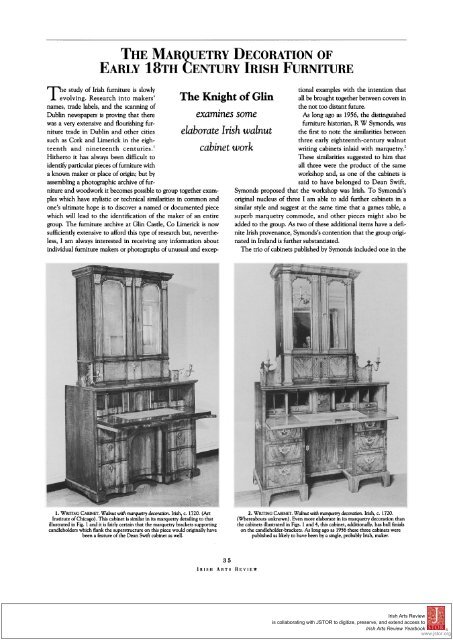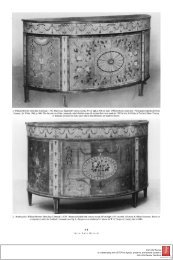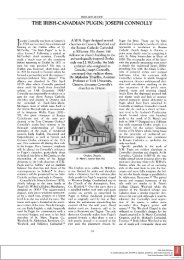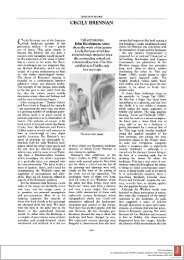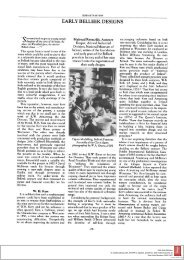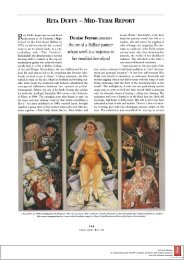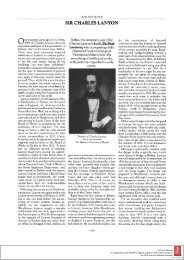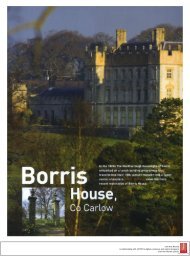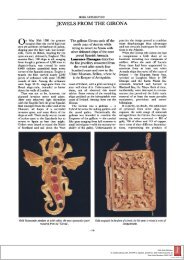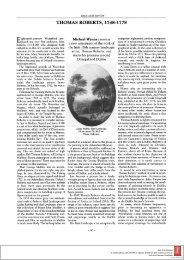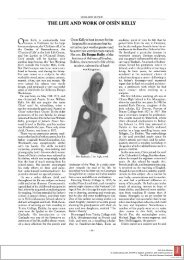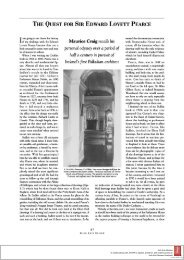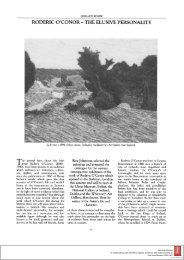the marquetry decoration of early 18th century ... - Irish Arts Review
the marquetry decoration of early 18th century ... - Irish Arts Review
the marquetry decoration of early 18th century ... - Irish Arts Review
You also want an ePaper? Increase the reach of your titles
YUMPU automatically turns print PDFs into web optimized ePapers that Google loves.
THE MARQUETRY DECORATION OF<br />
EARLY 18TH CENTURY IRISH FURNITURE<br />
T he study <strong>of</strong> <strong>Irish</strong> fumiture is slowly<br />
evolving. Research into makers'<br />
names, trade labels, and <strong>the</strong> scanning <strong>of</strong><br />
Dublin newspapers is proving that <strong>the</strong>re<br />
was a very extensive and flourishing fur<br />
niture trade in Dublin and o<strong>the</strong>r cities<br />
such as Cork and Limerick in <strong>the</strong> eigh<br />
teenth and nineteenth centuries.'<br />
Hi<strong>the</strong>rto it has always been difficult to<br />
identify particular pieces <strong>of</strong> furniture with<br />
a known maker or place <strong>of</strong> origin; but by<br />
assembling a photographic archive <strong>of</strong> fur<br />
The Knight <strong>of</strong> Glin<br />
niture and woodwork it becomes possible to group toge<strong>the</strong>r exam<br />
ples which have stylistic or technical similarities in common and<br />
one's ultimate hope is to discover a named or documented piece<br />
which will lead to <strong>the</strong> identification <strong>of</strong> <strong>the</strong> maker <strong>of</strong> an entire<br />
group. The fumiture archive at Glin Castle, Co Limerick is now<br />
sufficiently extensive to afford this type <strong>of</strong> research but, never<strong>the</strong><br />
less, I am always interested in receiving any information about<br />
individual furniture makers or photographs <strong>of</strong> unusual and excep<br />
1. WRMING CABINET. Walnut with marquetiy <strong>decoration</strong>. <strong>Irish</strong>, c. 1720. (Art<br />
Institute <strong>of</strong> Chicago). This cabinet is similar in its <strong>marquetry</strong> detailing to that<br />
illustrated in Fig. 1 and it is fairly certain that <strong>the</strong> <strong>marquetry</strong> brackets supporting<br />
candleholders which flank <strong>the</strong> superstructure on this piece would originally have<br />
been a feature <strong>of</strong> <strong>the</strong> Dean Swift cabinet as well.<br />
examines some<br />
elaborate <strong>Irish</strong> walnut<br />
cabinet work<br />
35<br />
IRISH ARTS REVIEW<br />
tional examples with <strong>the</strong> intention that<br />
all be brought toge<strong>the</strong>r between covers in<br />
<strong>the</strong> not too distant future.<br />
As long ago as 1956, <strong>the</strong> distinguished<br />
furniture historian, R W Symonds, was<br />
<strong>the</strong> first to note <strong>the</strong> similarities between<br />
three <strong>early</strong> eighteenth-<strong>century</strong> walnut<br />
writing cabinets inlaid with <strong>marquetry</strong>.2<br />
These similarities suggested to him that<br />
all three were <strong>the</strong> product <strong>of</strong> <strong>the</strong> same<br />
workshop and, as one <strong>of</strong> <strong>the</strong> cabinets is<br />
said to have belonged to Dean Swift,<br />
Symonds proposed that <strong>the</strong> workshop was <strong>Irish</strong>. To Symonds's<br />
original nucleus <strong>of</strong> three I am able to add fur<strong>the</strong>r cabinets in a<br />
similar style and suggest at <strong>the</strong> same time that a games table, a<br />
superb <strong>marquetry</strong> commode, and o<strong>the</strong>r pieces might also be<br />
added to <strong>the</strong> group. As two <strong>of</strong> <strong>the</strong>se additional items have a defi<br />
nite <strong>Irish</strong> provenance, Symonds's contention that <strong>the</strong> group origi<br />
nated in Ireland is fur<strong>the</strong>r substantiated.<br />
The trio <strong>of</strong> cabinets published by Symonds included one in <strong>the</strong><br />
2. WRITING CABINET. Walnut with <strong>marquetry</strong> <strong>decoration</strong>. <strong>Irish</strong>, c. 1720.<br />
(Whereabouts unknown). Even more elaborate in its <strong>marquetry</strong> <strong>decoration</strong> than<br />
<strong>the</strong> cabinets illustrated in Figs. 1 and 4, this cabinet, additionally, has ball finials<br />
on <strong>the</strong> candleholder-brackets. As long ago as 1956 <strong>the</strong>se three cabinets were<br />
published as likely to have been by a single, probably <strong>Irish</strong>, maker.<br />
<strong>Irish</strong> <strong>Arts</strong> <strong>Review</strong><br />
is collaborating with JSTOR to digitize, preserve, and extend access to<br />
<strong>Irish</strong> <strong>Arts</strong> <strong>Review</strong> Yearbook ®<br />
www.jstor.org
~~~~~~~~~~~~~~~~~~~~~~~~~~~~~~~~~~<br />
I<br />
171
THE MARQUETRY DECORATION OF EARLY 18TH CENTURY IRISH FURNITURE<br />
Victoria & Albert Museum (Fig. 4), ano<strong>the</strong>r now in <strong>the</strong> Art<br />
Institute <strong>of</strong> Chicago (Fig. 1), and a third <strong>the</strong> present whereabouts<br />
<strong>of</strong> which is unknown (Fig. 2). The walnut writing cabinet in <strong>the</strong><br />
Victoria & Albert Museum3 is said to have belonged to Dean<br />
Swift. It has a base with niche-shaped fronts to <strong>the</strong><br />
drawers and a mirrored superstructure composed with<br />
Corinthian fluted pilasters and elaborate <strong>marquetry</strong><br />
<strong>decoration</strong> below <strong>the</strong> pilasters.<br />
The more elaborate example now in Chicago4 has a<br />
similar mirrored superstructure but is complete with<br />
<strong>marquetry</strong> decorated brackets supporting candlehold<br />
ers flanking this upper stage. It seems likely that <strong>the</strong><br />
V&A example had similar brackets although <strong>the</strong>y are<br />
now missing.5The pedestal <strong>of</strong> <strong>the</strong> Chicago desk is<br />
expansively composed, with moulded serpentine<br />
drawer fronts on ei<strong>the</strong>r side <strong>of</strong> <strong>the</strong> arched knee hole.<br />
Symonds's third example (Fig. 2),6similar to <strong>the</strong><br />
o<strong>the</strong>r two, has straight-fronted drawers, bracket feet,<br />
and a pilastered mirrored upper stage flanked by<br />
exaggerated spiral decorated <strong>marquetry</strong> brackets ter<br />
minated with ball finials. The candleholders are<br />
attached with escutcheons on <strong>the</strong> front <strong>of</strong> <strong>the</strong> brack<br />
ets identical to those in <strong>the</strong> Chicago example.<br />
The distinctive <strong>marquetry</strong> inlay on all <strong>the</strong>se cabi<br />
nets as well as o<strong>the</strong>r features, particularly <strong>the</strong> deco<br />
rated brackets for candleholders, allow one to identi<br />
fy o<strong>the</strong>r examples which most probably originated<br />
from <strong>the</strong> same workshop. The first is a cabinet from<br />
<strong>the</strong> Watney collection at Cornbury7 (Fig. 3) in<br />
Oxfordshire which appeared on <strong>the</strong> market in 1967.<br />
The pedestal has niche-shaped drawers similar to<br />
those in <strong>the</strong> V & A cabinet as well as <strong>the</strong> by now<br />
familiar spiral-decorated brackets with ball finials;<br />
but here <strong>the</strong>re are no candleholders. A new dimen<br />
sion is portrayed by <strong>the</strong> upper stage, which is sur<br />
mounted by a swan pediment with rosettes centred<br />
by a <strong>marquetry</strong> inlaid shell. The <strong>marquetry</strong> and bead<br />
ing relate closely to <strong>the</strong> previous three examples.<br />
A variation on <strong>the</strong> overall design <strong>of</strong> <strong>the</strong>se cabinets<br />
can be seen in <strong>the</strong> red walnut bureau cabinet now at<br />
Florence Court, County Fermanagh (Figs. 5 & 6).<br />
Here <strong>the</strong> pedestal with its drawers is abandoned and<br />
is superseded by an elaborate pull-out desk with a ris<br />
ing top on a ratchet. The desk is splendidly decorat<br />
ed with carved shells and broken cabriole legs termi<br />
nating in Spanish feet. The mirrored doors have also been jetti<br />
soned in favour <strong>of</strong> shaped panelled doors. The swan-necked<br />
pediment with its carved rosettes is inlaid with seaweed mar<br />
quetry incorporating Commedia dell 'Arte figures centred with a<br />
grotesque mask (Fig. 6). It would appear that this probably sup<br />
ported a fur<strong>the</strong>r piece <strong>of</strong> <strong>decoration</strong> such as a shell. The usual<br />
brackets with <strong>marquetry</strong> <strong>decoration</strong> flank <strong>the</strong> upper stage. Brass<br />
candleholders have been recently been added to this desk<br />
although it is unlikely that <strong>the</strong>y would ever have been <strong>the</strong>re as<br />
<strong>the</strong>re were swivel brass candlestands underneath <strong>the</strong> desk top<br />
3. WRITING CABINET. Walnut with <strong>marquetry</strong> <strong>decoration</strong>. <strong>Irish</strong>, c. 1720. (Formerly Oliver Watney<br />
collection, Combury Park). The design <strong>of</strong> this cabinet, with serpentine drawer fronts in <strong>the</strong><br />
pedestal, is similar to <strong>the</strong> Dean Swift cabinet but <strong>the</strong> swan-neck pediment with rosettes,<br />
providing scope for fur<strong>the</strong>r <strong>marquetry</strong> <strong>decoration</strong>, adds a new dimension to <strong>the</strong> overall effect.<br />
and <strong>the</strong>re would have been no need for both sets. The carving <strong>of</strong><br />
<strong>the</strong> lower section <strong>of</strong> this cabinet is very <strong>Irish</strong> in character.<br />
A very similar desk to this one appeared on <strong>the</strong> London mar<br />
ket in 19909 (Fig. 7). The elaborately carved acanthus-decorated<br />
frieze is centred with a shell and fantastical twin-headed dog or<br />
fox-like animals with curly tails lead down to <strong>the</strong> legs with <strong>the</strong>ir<br />
4. (Opposite). WRITING CABINET. Walnut with narquetry <strong>decoration</strong> <strong>Irish</strong>, c. 1720. (Victoria & Albert Museum). It is alleged that this cabinet once belonged to Dean Swift, a<br />
provenenance which would suggest that its maker was <strong>Irish</strong>. The distinctive <strong>marquetry</strong> detailing which is <strong>the</strong> subject <strong>of</strong> this article is found on <strong>the</strong> panels below <strong>the</strong> pilasters<br />
and also on <strong>the</strong> uprights <strong>of</strong> <strong>the</strong> desk section.<br />
37<br />
IRISH ARTS REVIEW
5. BUREAUj CABrNET. Red walnut with vnarquen-y <strong>decoration</strong>. <strong>Irish</strong>, c. 1730-40. (Florence Court, Co Fermanagh, Collection <strong>of</strong> <strong>the</strong> National Trust). The pedestal section <strong>of</strong> this<br />
cabinet, <strong>the</strong> carving on which is particularly <strong>Irish</strong>, is in <strong>the</strong> form <strong>of</strong> an elaborate pull-out desk with a rising top on a ratchet. As <strong>the</strong>re were swivel brass candlesticks underneath<br />
<strong>the</strong> desk-top, it is unlikely that <strong>the</strong>re would ever have been candleholders on <strong>the</strong> flanking <strong>marquetry</strong> brackets. Ball finials, such as in Figs 2 and 3, would have been likely.<br />
38<br />
I R ISH A R TS R EV IE W
THE MARQUETRY DECORATION OF EARLY 18TH CENTURY IRISH FURNITURE<br />
6. MARQUETRY DECORATION in <strong>the</strong> pediment <strong>of</strong> <strong>the</strong> bureau cabinet illustrated<br />
in Fig. 5. In a notable advancement on <strong>the</strong> use <strong>of</strong> <strong>marquetry</strong>, <strong>the</strong> pediment<br />
section <strong>of</strong> this cabinet has been used as a field for <strong>the</strong> most superb<br />
<strong>decoration</strong> with seaweed <strong>marquetry</strong>, Commnedia dell' Arte figures and a<br />
<strong>the</strong>atrical mask on <strong>the</strong> central panel which, almost certainly, would<br />
originally have supported a feature such as a shell or a crest.<br />
7. SIDE TABLE. Mahogany with <strong>marquetry</strong> <strong>decoration</strong> and marble top. <strong>Irish</strong>,<br />
mid-<strong>18th</strong> <strong>century</strong>. (Private collection, Dublin). Marquetry detailing is at<br />
its simplest on this table where a scallop shell flanked by acanthus is used<br />
to decorate <strong>the</strong> apron. In some examples a <strong>marquetry</strong> crest is placed in <strong>the</strong><br />
same position.<br />
Spanish feet. The desk pulls out and <strong>the</strong> top rises on a ratchet.<br />
Again <strong>the</strong> doors are panelled ra<strong>the</strong>r than mirrored. Swivel<br />
candlestands <strong>of</strong> brass appear undemeath <strong>the</strong> rising top (as in <strong>the</strong><br />
previously described example) and <strong>the</strong> <strong>marquetry</strong> acanthus-deco<br />
rated spiral brackets appear not to have had any balls or candle<br />
holders. The upper section is surmounted by a ra<strong>the</strong>r diminutive<br />
swan pediment which encloses very large spiral <strong>decoration</strong> similar<br />
to <strong>the</strong> <strong>decoration</strong> <strong>of</strong> <strong>the</strong> Watney cabinet (Fig. 3).<br />
The last example <strong>of</strong> this obviously related group <strong>of</strong> bureau<br />
8. ARCHITECT'S WRITING TABLE AND CABINET. Mahogany with narquetry <strong>decoration</strong>. <strong>Irish</strong><br />
mid-<strong>18th</strong> <strong>century</strong>. (Private collection). Similar in form to <strong>the</strong> desk illustrated in Fig. 5,<br />
but with pr<strong>of</strong>use carved <strong>decoration</strong> on <strong>the</strong> pedestal section, this cabinet also features <strong>the</strong><br />
by-now familiar <strong>marquetry</strong> pediment.<br />
39<br />
IRISH ARTS REVIEW<br />
cabinets is <strong>the</strong> plainest <strong>of</strong> <strong>the</strong>m all. It was found in a house sale in<br />
1992 at Stackallan, Co Meath'" (Fig. 12). Again as in <strong>the</strong> exam<br />
ple in Fig. 5, a pullout desk, with a fitted interior and a set <strong>of</strong><br />
nine drawers below, supports a rising top with a ratchet; <strong>the</strong> swiv<br />
el candleholders, now missing, were obviously similar to those in<br />
<strong>the</strong> Florence Court cabinet as shaped places for <strong>the</strong>m show that<br />
<strong>the</strong>y must have been fitted undemeath <strong>the</strong> top <strong>of</strong> <strong>the</strong> desk. The<br />
acanthus-decorated brackets are terminated with balls similar to<br />
those in o<strong>the</strong>r examples (see Figs. 2, 3 and 12) and it seems likely
9. GAMES TABLE. Walnut with narquetry <strong>decoration</strong>. <strong>Irish</strong>, mid <strong>18th</strong> <strong>century</strong>. (Private collection). The <strong>marquetry</strong> work on this table is very extensive with a shell on <strong>the</strong> front <strong>of</strong><br />
<strong>the</strong> box above <strong>the</strong> chessboard, fur<strong>the</strong>r <strong>decoration</strong> on <strong>the</strong> legs and on <strong>the</strong> surface <strong>of</strong> <strong>the</strong> candlestands which, in turn, fold down to form part <strong>of</strong> <strong>the</strong> embellishment <strong>of</strong> <strong>the</strong> sides.<br />
10. THE BLESSIlNrOTN COMMODE. Walnut with <strong>marquetry</strong> <strong>decoration</strong>. <strong>Irish</strong>, c. 1745. (Private collection). This exceptional piece, pr<strong>of</strong>usely covered in seaweed <strong>marquetry</strong>, is<br />
inlaid on <strong>the</strong> top with <strong>the</strong> arms <strong>of</strong> William Stewart, 5th Baronet <strong>of</strong> Ramelton, 3rd Viscount Mountjoy, and Earl <strong>of</strong> Blessington. Although <strong>the</strong> <strong>marquetry</strong> is very much in <strong>the</strong><br />
manner <strong>of</strong> Gerrit Jensen, it is here suggested that <strong>the</strong> commode is <strong>Irish</strong>.<br />
40<br />
I R ISH A R TS R EV IE W
1 1 .WRrrING CABINET. Mahogany with mnarquetty <strong>decoration</strong>. <strong>Irish</strong> mid- <strong>18th</strong> <strong>century</strong>. (Pnivate collection, Belfast) .This cabinet with <strong>marquetry</strong> pilasters in <strong>the</strong> fitted desk<br />
and in <strong>the</strong> pediment, is an example <strong>of</strong> how such <strong>decoration</strong> was employed on plainer examples <strong>of</strong> Inish furniture by <strong>the</strong> mid- <strong>18th</strong> <strong>century</strong> suggesting <strong>the</strong> possibility that<br />
specialist craftsmen may have supplied such details to o<strong>the</strong>r cabinetmakers.<br />
41<br />
I R ISh1 A R TS R E VIE W
THE MARQUETRY DECORATION OF EARLY 18TH CENTURY IRISH FURNITURE<br />
that <strong>the</strong>re were no fur<strong>the</strong>r candle<br />
<strong>marquetry</strong> <strong>decoration</strong> flanking <strong>the</strong><br />
holders, <strong>the</strong> ones below <strong>the</strong> desk top<br />
arms incorporates masks very simi<br />
sufficing. The superstructure is quite<br />
lar to that centering <strong>the</strong> pediment<br />
plain with panelled doors; <strong>the</strong> base<br />
<strong>of</strong> <strong>the</strong> Florence Court cabinet (Fig.<br />
has elegantly composed scrolled legs<br />
5). The whole surface <strong>of</strong> <strong>the</strong> com<br />
and faceted club feet, very typical<br />
mode is overloaded with this Gerrit<br />
for <strong>Irish</strong> fumiture <strong>of</strong> this period.<br />
Jensen-like <strong>decoration</strong>, which<br />
The <strong>marquetry</strong> <strong>decoration</strong> on<br />
seems very old fashioned for <strong>the</strong><br />
<strong>the</strong>se cabinets leads me to identify<br />
mid-<strong>century</strong>. This piece is now in a<br />
ano<strong>the</strong>r relatively plain piece <strong>of</strong> fur<br />
private collection in Ireland.<br />
niture as relating to <strong>the</strong> group. This<br />
The whole <strong>of</strong> this quirky group<br />
is a turnover-top walnut games<br />
shows a lively provincial flavour.<br />
table which appeared on <strong>the</strong> New<br />
Although we have no documenta<br />
York market in 199311 (Fig. 9). The<br />
tion about who made <strong>the</strong>se pieces,<br />
backgammon board is concealed in<br />
it seems not unlikely that <strong>the</strong>y were<br />
<strong>the</strong> box <strong>of</strong> <strong>the</strong> table which itself is<br />
<strong>the</strong> work <strong>of</strong> some French or Dutch<br />
inlaid with a <strong>marquetry</strong> shell. The<br />
craftsmen, possibly Huguenot.<br />
cabriole legs are beautifully inlaid<br />
They may have worked in a Dublin<br />
with <strong>marquetry</strong> and decorated with<br />
workshop <strong>of</strong> <strong>the</strong> period with o<strong>the</strong>r<br />
little inlaid curls under <strong>the</strong> cabriole<br />
<strong>Irish</strong> carvers and cabinet makers<br />
legs <strong>the</strong>mselves. An ingenious<br />
who, <strong>of</strong> course, provided <strong>the</strong> carv<br />
touch is that <strong>the</strong> candlestands snap<br />
ing and casework. It is interesting<br />
down to <strong>the</strong> side and form part <strong>of</strong><br />
to note that in <strong>the</strong> past some <strong>of</strong><br />
<strong>the</strong> moulded <strong>decoration</strong> <strong>of</strong> <strong>the</strong><br />
<strong>the</strong>se pieces have been called<br />
sides. It is certainly <strong>the</strong> finest <strong>Irish</strong><br />
Anglo-Dutch.<br />
games table so far known.<br />
O<strong>the</strong>r <strong>marquetry</strong> details such as<br />
To substantiate <strong>the</strong> claim that<br />
crests, cartouches, shells, and finials<br />
this group <strong>of</strong> fumiture, linked as it<br />
appear on o<strong>the</strong>r plainer pieces <strong>of</strong><br />
is by <strong>marquetry</strong> <strong>decoration</strong>, is <strong>Irish</strong><br />
I am suggesting a similar origin for<br />
a magnificent seaweed decorated<br />
12. SECRETAIRE CABINET. Walnut with marquety <strong>decoration</strong>. <strong>Irish</strong>,<br />
mid-<strong>18th</strong> <strong>century</strong>. (Private collection, formerly Stackallan House,<br />
Co Meath). Although very plain in appearance, this cabinet is rela<br />
tively sophisticated in its cabinet work with a pull-out desk, a rising<br />
<strong>Irish</strong> walnut and mahogany furni<br />
ture (Figs.7 & 11)." This would<br />
suggest that <strong>marquetry</strong> detailing<br />
bombe commode'2 which was<br />
recently sold on <strong>the</strong> London mar<br />
top supported by a ratchet, and nine fitted drawers in <strong>the</strong> interior<br />
<strong>of</strong> <strong>the</strong> pedestal. The <strong>marquetry</strong> <strong>decoration</strong> is limited to <strong>the</strong> candle<br />
holder brackets with ball finials. The facetted club feet are very<br />
would have been provided by a<br />
<strong>marquetry</strong> specialist for any crafts<br />
ket (Fig. 10). It bears <strong>the</strong> grandilo<br />
typical for <strong>Irish</strong> furniture <strong>of</strong> this period.<br />
man who fancied additional orna<br />
quent coat-<strong>of</strong>-arms <strong>of</strong> William<br />
mentation on his pieces.<br />
Stewart, 3rd Viscount Mountjoy, who was later created <strong>the</strong> first<br />
Earl <strong>of</strong> Blessington. The <strong>marquetry</strong> achievement bears an Earl's<br />
Would that we knew more <strong>of</strong> <strong>the</strong> identity <strong>of</strong> <strong>the</strong>se craftsmen!<br />
coronet enabling us to date it between <strong>the</strong> creation in 1745 and DESMOND FITZGERALD, THE KNIGHT OF GLIN, has written and<br />
<strong>the</strong> Earl's death in 1769 although it was most likely commis lectured extensively on <strong>Irish</strong> art, architecture and <strong>the</strong> decorative arts.<br />
sioned at <strong>the</strong> time <strong>of</strong> his step in <strong>the</strong> peerage. The Berainesque He is President <strong>of</strong> <strong>the</strong> <strong>Irish</strong> Georgian Society.<br />
1. See Desmond Fitzgerald, Knight <strong>of</strong> Glin,<br />
'Dublin Directories and Trade Labels',<br />
Furniture History, XXI (1985), ppl 15-32; 'Early<br />
<strong>Irish</strong> Trade Cards and o<strong>the</strong>r Eighteenth<br />
Century Ephemera' Eighteenth Century Ireland,<br />
II, (1987) pp.115-132; 'A Directory <strong>of</strong> <strong>the</strong><br />
Dublin Furniture Trade 1752-1800' reprinted<br />
by <strong>the</strong> <strong>Irish</strong> Georgian Society, Dublin 1993,<br />
from A Bemelle (?d.) D?cantations A Tribute in<br />
Honour <strong>of</strong> Maurice Craig, Dublin 1992, p.47-59.<br />
2. RW Symonds, 'Dean Swift's Writing Cabinet<br />
and Two O<strong>the</strong>rs' The Antique Collector, Vol.<br />
27, No. 7, April 1956, pp.60-63.<br />
3. Accession No. W 32-1912. James Yorke <strong>of</strong><br />
<strong>the</strong> Dept. <strong>of</strong> Furniture & Woodwork at <strong>the</strong><br />
V &. A assisted my researches.<br />
4. Accession No. AIC 57 200, Gift <strong>of</strong> Robert<br />
Allerton. See Meyric Rogers, The Art Institute<br />
<strong>of</strong> Chicago Quarterly, Vol LI, No. 4, November<br />
15, 1957, p.85.1 am indebted to Lynn<br />
Springer Rogers, late <strong>of</strong> <strong>the</strong> European<br />
Decorative <strong>Arts</strong> Dept., for assistance in looking<br />
at this piece and for access to her files. Also to<br />
Ian Wardropper for additional help.<br />
5. Information from <strong>the</strong> late John Hayward <strong>of</strong> <strong>the</strong><br />
Victoria & Albert Museum to <strong>the</strong> author. The<br />
veneers on <strong>the</strong> side surfaces <strong>of</strong> <strong>the</strong> cabinet,<br />
where <strong>the</strong> brackets would have been, have<br />
been replaced, which supports this supposition.<br />
6. Sold from <strong>the</strong> Collection <strong>of</strong> Billy Rose, Parke<br />
Bernet, New York, 22 April, 1967, lot 87 and<br />
<strong>the</strong>n with Stair & Company, New York, 1967.<br />
7. Christie's, Combury Park, 22 May 1967, lot 147.<br />
8. Christie's, Croxton Park, 20 September 1982.<br />
42<br />
IRISH ARTS REVIEW<br />
See also ApoUo, Vol. CXLI, No. 399,<br />
Nov. 1995, p.74.<br />
9. So<strong>the</strong>by's, Nov. 1990, lot 279, now in a<br />
private collection in Wiltshire.<br />
10. Christie's, Stackallan House, 20 October<br />
1992, lot 100.<br />
11. Christie's New York, 9 October 1993, lot 319.<br />
12. So<strong>the</strong>by's, London, 2 June 1995, lot 12.<br />
13. For instance, a bureau bookcase in a private<br />
collection in Belfast has a<br />
scallop shell<br />
centering its swan<br />
pediment and a goat crest in<br />
a cartouche (Fig.l 1). A red walnut marble<br />
sidetable in a Dublin collection has a<br />
topped<br />
wyvern crest in a cartouche on <strong>the</strong> friezes, a<br />
fur<strong>the</strong>r sidetable in ano<strong>the</strong>r Dublin collection<br />
has a scallop shell with flanking acanthus on its<br />
frieze (Fig.7).


